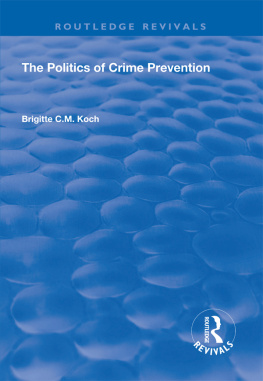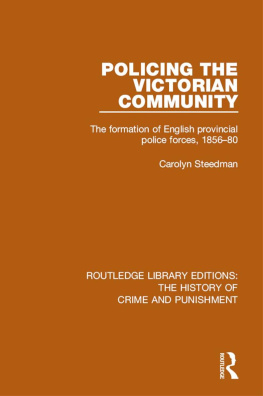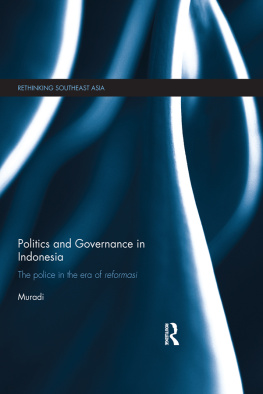The Chief Constables of England and Wales
Driving one morning with him to Shiply Lane End, a favourite meet, he said: How would the Chief Constableship of the county suit you? He had held the appointment himself before succeeding to a fortune. Nothing in the world, I replied, would suit me better. Well, he continued, I think that may be arranged. All good has completely broken down and cant last long now (Sir Henry Smith, KCB., 1910: 82).
First published 1998 by Dartmouth and Ashgate Publishing
Reissued 2018 by Routledge
2 Park Square, Milton Park, Abingdon, Oxon, OX14 4RN
52 Vanderbilt Avenue, New York, NY 10017
Routledge is an imprint of the Taylor & Francis Group, an informa business
Copyright David S. Wall 1998
All rights reserved. No part of this book may be reprinted or reproduced or utilised in any form or by any electronic, mechanical, or other means, now known or hereafter invented, including photocopying and recording, or in any information storage or retrieval system, without permission in writing from the publishers.
Notice:
Product or corporate names may be trademarks or registered trademarks, and are used only for identification and explanation without intent to infringe.
Publishers Note
The publisher has gone to great lengths to ensure the quality of this reprint but points out that some imperfections in the original copies may be apparent.
Disclaimer
The publisher has made every effort to trace copyright holders and welcomes correspondence from those they have been unable to contact.
A Library of Congress record exists under LC control number: 98018562
ISBN 13: 978-1-138-34226-2 (hbk)
ISBN 13: 978-0-429-43982-7 (ebk)
: The annual number of all independent police forces in England and Wales 1836-1996
: A typical advertisement for a chief constable, 1894
: Advertisement for a borough chief constable, 1888
: Chief constables appointed without UK police experience
: The impact of the Hendon scheme (1934-1939)
: The occupational origins of chief constables 1836 - 1996
: Numbers of appointments as chief police officer
: The impact of the borough police reforms 1835-1853
: The impact of the county police reforms 1839-1857
: Growth in provincial police numbers and force size
: The social composition of the county magistracy
: The composition of the applicants for the Buckinghamshire post
: Turnover of chief constables (leaving office)
: Entry into the Metropolitan Police College
: The progress of the Police College Graduates
: Attainment in the police service by mode of entry to the Metropolitan Police College of senior police officers serving in 1965
: The previous occupations of chief constables
: Mode of entry into the police
: Mode of entry into the police over time
: Average age upon joining the police
: Average length of service prior to appointment
: Number of forces served in prior to appointment
: Changes in number of forces served in before appointment
: Previous rank and type of force served in
: Chief constables whose first force was the Metropolitan police
: Average age on appointment as chief constable
: Average number of years in office
: Average age upon leaving office
: Reasons for leaving office
: Force sizes and changes of command
: Number of appointments held as chief constable
: Occupation between leaving school and joining police
: Extent of military service
: Average length of military service (in years)
: Highest military rank held
: Changes in military rank
: Branch of armed forces served in
: Secondary education
: Changes in secondary education over time
: Comparing secondary education (1976, 1986 and 1996)
: Further or higher education
: Changes in further or higher education
: Academic qualifications
: University degrees
: Fathers Occupations (Before 1974)
: Entry in a directory of lites by force type
: Entry in a directory of lites: ten year intervals
: Chief Constables with titles
: ACPO presidents and HMICs with titles
1722 - Criminal Law Act (9 George 1, c. 22)
1829 - Metropolitan Police Act (10 George IV, c.44)
1830 - Lighting and Watching Act (11 George IV and 1 William IV, c.27)
1831 - Special Constables Act (1 & 2 William IV, c.39,41)
1835 - Municipal Corporations Act (5 & 6 William IV, c.76)
1839 - Metropolitan Police Act (2 & 3 Vict, c.47)
1839 - Manchester Police Act (2 & 3 Vict, c.87)
1839 - County Police Act (2 & 3 Vict, c.93)
1840 - County Police Act (3 & 4 Vict, c.88)
1856 - County and Borough Police Act (19 & 20 Victoria c. 69)
1882 - Municipal Corporations Act (45 & 46 Vict. c. 50)
1888 - Local Government Act (51 & 52 Vict. c. 41)
1890 - Police Act (53 & 54 Vict. c. 45)
1919 - Police Act (9 & 10 Geo. V, c. 46)
1946 - Police Act (11 &12 Geo. 5 c. 31)
1964 - Police Act (c.48)
1972 - Local Government Act (c.70)
1984 - Police and Criminal Evidence Act (c.60)
1985 - Prosecution of Offences Act (c.23)
1986 - Public Order Act (c.64)
1991 - Criminal Justice Act (c.53)
1992 - Criminal Justice Act (c.36)
1994 - Criminal Justice and Public Order Act (c.33)
1994 - Intelligence Services Act (c. 13)
1994 - Police and Magistrates Courts Act (c.29)
1996 - Police Act (c. 16)
1996 - Security Service Act (c.35)
1997 - Police Act (c.50)
Fisher v Oldham Corporation [1930] 2 K.B. 364
Ridge v Baldwin [1964] A.C. 40
R v Chief Constable of the Devon and Cornwall Constabulary, ex parte Central Electricity Generating Board [1981] 3 All ER 826
R v Secretary of State for the Home Department, ex parte Northumbria Police Authority [1987] 2 All ER 282
R v Chief Constable of Sussex, ex parte International Traders Ferry Ltd [1995] 4 All ER 364
Gustave Flaubert once said that books are not made the same way that babies are, rather, they are made like pyramids. He went on to say that after some long pondered plan, great blocks of stone are placed upon each other through back-breaking, sweaty and time-consuming work. But to what purpose! it just stands there in the desert, yet towers over it prodigiously with the jackals urinating on the base and the bourgeois clambering up to the top (Barnes, 1984: 35-36).
This book is certainly the product of some long pondered plan. It brings together great blocks of stone (data) from two studies that were carried out almost a decade apart. The first study was carried out under an ESRC research training award and the second was funded by the Nuffield Foundation. To both organisations, I am grateful as the first project enabled me to collect the bulk of the quantitative data and the second enabled me to collect the qualitative data and also more of the quantitative. I am also indebted to my colleagues in the Department of Law at the University of Leeds for giving me study leave during the first semester of 1997.






